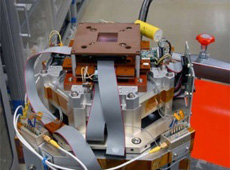
Prototype model of Si/CdTe Compton camera, which works with the soft gamma-ray detector

Application of Si/CdTe Compton camera to heavy iron micro surgery

Microcalorimeter
ASTRO-H will carry instruments based on leading technologies. Although these were developed to measure X-rays and gamma rays in space, they also have numerous applications on Earth. Also, the constraints of a space based environment means that the satellite and its payload have to be extremely efficient, robust, and reliable whilst remaining lightweight, so this develops the technology required for lower power, smaller devices. Additionally, space based electronics have to be able to operate despite being exposed to cosmic radiation, predominantly high energy particles accelerated by solar flares. Developing such technology also has uses in extreme environments on Earth
For example, the ASTRO-H soft gamma-ray detector which was developed in Japan is an instrument which can measure the wavelength and intensity of very high energy photons. This can be used in medicine as an extremely compact, innovative medical device much better than anything currently available. The technology will advance both radiology and heavy iron radiotherapy, enabling doctors to pinpoint cancer tumors previously too small to locate, and to burn them with a focused beam.
Similarly, the remarkable energy resolution of the X-ray microcalorimeter could help drastically improve conventional electron microscopes. These microscopes are a key technology used in a wide range of research areas, such as nanotechnology, nanomaterials and biotechnology. Using a new version of the microcalorimeter, which is a technology upgraded for ASTRO-H, it will become possible to greatly improve the accuracy of component analysis, for example detecting miniscule impurities in the semiconductor chips used in integrated memory circuits that allow the storage of large volumes of data.



